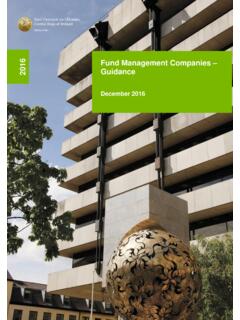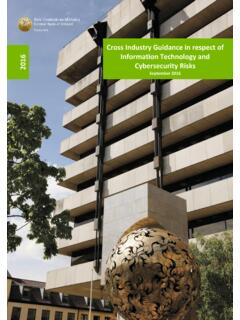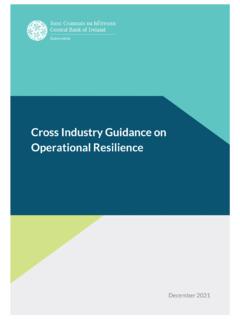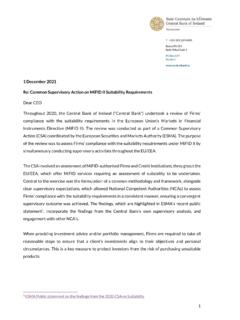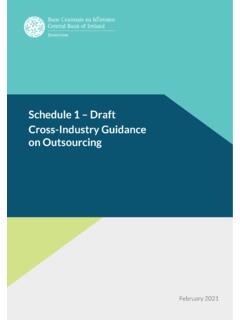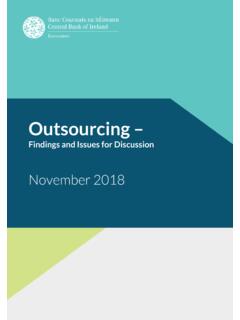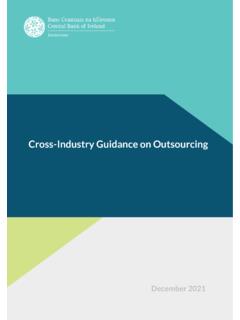Transcription of The impact of Covid-19 on consumer spending
1 T: +353 (0)1 224 6000 E: December 2020 The impact of Covid-19 on consumer spending Stephen Byrne, Andrew Hopkins, Tara McIndoe-Calder, Martina Sherman Vol 2020, No. 15 impact of Covid-19 on consumer spending Central Bank of Ireland Page 1 The impact of Covid-19 on consumer spending Stephen Byrne,1 Andrew Hopkins,1 Tara McIndoe-Calder,1 Martina Sherman1* Abstract. This letter describes the impact of the pandemic on private consumption , which accounts for just over half of national income (GNI*).
2 We outline a methodology for using high-frequency data to track developments in consumption , and show the importance of accounting for pandemic-induced changes in spending patterns when measuring aggregate output. The expansion of firms online presence has mitigated the effect of the pandemic on total spending . The impact of the pandemic has varied across income groups with low income households more likely to see spending falls. While there may be significant forced savings accumulated as a result of the pandemic, this has largely been concentrated in higher income households.
3 These households spend relatively less of each euro of additional income in normal times, meaning that the boost to consumption when the pandemic is over is likely to be lower than would be the case if the shock had been equally distributed. 1. Introduction The Covid-19 pandemic has had a large impact on the domestic economy, of which spending by households is a substantial component. consumer spending accounts for half of national income (GNI*) and in the second and third quarter of 2020 it fell by percent, compared to a year earlier.
4 Daily data see an average fall in personal card spending of per cent in October and November, compared to the same months in Using a novel methodology which accounts for spending weights, we use the high-frequency card payment data alone to estimate a per cent year-on-year decline in aggregate consumption in the second and third quarters, very close to the National Accounts data for the same period. This letter does four things. First, we use the Bank s card payment data to show the scale of the downturn in consumer spending , and how it has impacted high-contact settings such as restaurants, travel and entertainment particularly sharply.
5 Second, we analyse the relative roles of the public health restrictions themselves, and show that restrictions have meant that those who did not suffer a change in their labour market circumstances still reduced their spending 1 Economics and Statistics Directorate, Central Bank of Ireland Corresponding author: * The views expressed here are those of the authors rather than the Central Bank of Ireland or the Eurosystem. We are grateful for comments from Mark Cassidy, John Flynn, Reamonn Lydon, Rory McElligott, Caroline Mehigan, Gerard O Reilly and Maria Woods.
6 Remaining errors are our own. 2 Daily data is not available at sectoral level and is thus difficult to adjust for non-card spending effects. impact of Covid-19 on consumer spending Central Bank of Ireland Page 2 significantly. Third, the pandemic has seen a significant reallocation between different types of spending . We outline a method for understanding the impact of reallocation in consumer spending baskets on overall consumption growth during the pandemic. Fourth, we show that a significant proportion (between 50 and 88 per cent) of savings accumulated during the second quarter may be forced.
7 These savings have been largely concentrated in higher income households. Further, we show that these households spend relatively less of each euro of additional income in normal times, meaning that the boost to consumption when the pandemic is over is likely to be lower than would be the case if the shock had been equally distributed. We focus on the short-run effect of Covid-19 on consumption dynamics. While it is likely that the pandemic will have permanent effects on consumption preferences, these effects are beyond the scope of this Letter.
8 2. spending during Covid-19 The Covid-19 pandemic, and the measures to contain the spread of the virus, have had an impact on consumer spending through three different channels: 1) Opportunity to Spend: Restrictions on activity have limited opportunities to spend over an extended period (Hopkins and Sherman, 2020), shifting spending towards available goods and reducing overall spending . With incomes supported, the reduced opportunity to spend has generated a rise in savings that can be thought of as forced savings.
9 2) Willingness to spend: Living with the virus has changed the way many people live. Even without formal restrictions consumers can avoid activities perceived to be high-risk in terms of contracting the virus (Krueger et al, 2020). 3) Precautionary Saving: When uncertainty increases, consumers tend to reduce their discretionary spending and increase their precautionary savings. Thus, actual and expected income loss can cause people to save more (Heffernan, Saupe and Woods, 2020). The interactions between the three channels described above can be seen in Figure 1.
10 Those who experienced income declines and/or saw changes in labour market activity were most likely to reduce their expenditure since March. However, large numbers of people who remained in employment and those who saw no changes in their income also registered spending declines, reflecting the roles of reduced opportunities for consumption , and changes in the willingness to spend due to the virus and precautionary saving. impact of Covid-19 on consumer spending Central Bank of Ireland Page 3 Figure 1: Share of respondents who reduced expenditure during the Covid-19 restrictions by change in income and labour market activity, per centSource: CSO, Social impact of Covid-19 Survey June 2020: A Snapshot of Experiences and Expectations in a Pandemic, 2020.
